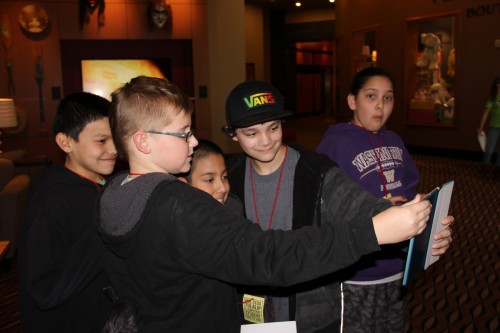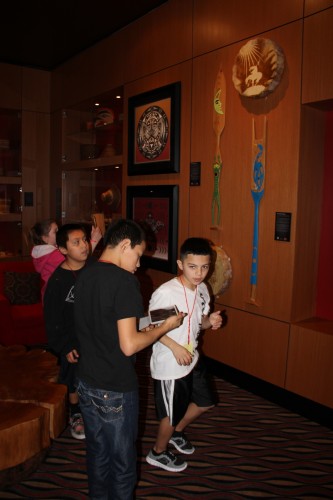Press release, U.S. Department of the Interior
Proposal for Fiscal Year 2015 fully funds contract support costs, launches the “Tiwahe Initiative” to address family welfare and poverty issues, invests in education, economic development, and sustainable stewardship of natural resources, and advances a strategy to reduce incarceration in Indian Country.
WASHINGTON, D.C. – President Obama’s Fiscal Year 2015 budget request for Indian Affairs, which includes the Bureau of Indian Affairs (BIA) and the Bureau of Indian Education (BIE), is $2.6 billion – a $33.6 million increase above the FY 2014 enacted level. The request maintains the President’s commitment to meet the Federal government’s responsibilities to the 566 federally recognized American Indian and Alaska Native Tribes by promoting stronger tribal economies, communities and families.
On June 26, 2013, President Obama appointed Interior Secretary Sally Jewell as the Chair of the White House Council on Native American Affairs. To underscore the President’s commitment to effective partnerships with American Indian and Alaska Native communities, the Council was established by Executive Order to enable Federal agencies to work more collaboratively and effectively with federally recognized Tribes to advance their economic and social priorities. The White House Council is a comprehensive multi-year effort to improve conditions for American Indians and Alaska Natives throughout Indian Country. Informed by consultation with the Tribes and reflective of tribal priorities, Interior’s 2015 budget continues the initiative’s focus on improved self-determination for tribal nations, safety of Indian communities, trust resource management, and post-secondary, elementary, and secondary education.
“The President’s Fiscal Year 2015 budget request continues to support Indian Affairs’ efforts to advance tribal self-governance and self-determination,” said Assistant Secretary – Indian Affairs Kevin K. Washburn. “In a budgetary climate that remains challenging, President Obama has made Indian tribes a priority, providing for the prudent management of tribal energy and natural resources, building stronger tribal economies, stabilizing families and creating safer tribal communities, expanding educational opportunities and increasing student achievement, restoring tribal homelands, and protecting tribal treaty rights.”
Among the major highlights, the budget proposal fully funds contract support costs that Tribes incur as managers of programs serving Native Americans and proposes a new Tiwahe Initiative, which integrates social services and job training programs to address the interrelated issues of poverty and child and family welfare. The President’s Opportunity, Growth, and Security Initiative would further invest in economic development and education in Indian Country to promote strong, resilient tribal economies and dramatically improve educational opportunities.
The Strengthening Tribal Nations Initiative
The Strengthening Tribal Nations Initiative is one of the Department of the Interior’s key priorities, involving a comprehensive effort to advance the President’s commitments to American Indians and Alaska Natives to improve conditions throughout Indian Country. The FY 2015 request includes $26.5 million in program increases for four areas: Advancing Nation-to-Nation Relationships, Supporting Indian Families and Protecting Indian Country, Supporting Sustainable Stewardship of Trust Resources, and Advancing Indian Education.
The request also proposes a total of $922.6 million in Tribal Priority Allocations, an increase of $19.3 million over the FY 2014 enacted level.
Advancing Nation-to-Nation Relationships
The FY 2015 budget request for Contract Support, including the Indian Self-Determination Fund, is $251.0 million, a $4.0 million increase over the FY 2014 enacted level. The FY 2015 budget request fully funds estimated 2015 contract support costs.
Public Law 93-638, the Indian Self-determination and Education Assistance Act, allows federally recognized Tribes to operate Federal programs themselves under contract with the United States. Known as 638 contracts, they are an expression of the Federal government’s policy to support tribal self-determination and self-governance. Tribes rely on contract support funds to pay the costs of administering and managing contracted programs. The availability of contract support cost funding is a key factor in a Tribe’s decision and ability to assume responsibility for operating Federal programs.
To facilitate tribal 638 contracting, the request includes an additional $1.2 million to increase services provided by the Department’s Office of Indirect Cost Negotiations, which negotiates indirect cost rates with non-Federal entities, including tribal governments, that contract with Interior in accordance with Federal regulations.
Indian Affairs, in conjunction with the Indian Health Service, will hold a tribal consultation session on March 11, 2014 in Washington, D.C., to identify long-term solutions for streamlining and funding contract support costs.
To further enhance the Nation-to-Nation relationship, Indian Affairs is continuing its comprehensive look at Federal acknowledgment regulations, with the intent of publishing a proposed rule in 2014. The FY 2015 budget also proposes language to clarify the Secretary of the Interior’s authority to take land into trust and to amend the Indian Reorganization Act of 1934 to reduce significant delays in processing fee-to-trust applications.
Supporting Indian Families and Protecting Indian Country
The FY 2015 budget proposes an $11.6 million increase for the Tiwahe Initiative to carry out the President’s commitment to protect and promote prosperous tribal communities. Tiwahe is Lakota for “family.” The Initiative provides a comprehensive and integrated approach to address the interrelated problems of poverty, violence, and substance abuse in American Indian communities. Through this Initiative, social services and job training programs will be integrated and expanded to address child and family welfare, job training, and incarceration issues, with the goal of promoting family stability and strengthening tribal communities.
The Initiative includes:
· An increase of $10.0 million to build on BIA’s social services and Indian child welfare programs with the goal of empowering American Indian and Alaska Native individuals and families in health and family stability, thereby strengthening tribal communities as a whole,
· $1.0 million to develop and institutionalize a program to effectively target funding and evaluate outcomes in meeting social service needs in Indian Country, and
· A program increase of $550,000 to expand job placement and training programs.
The BIA’s Housing Improvement Program will continue to provide services which result in more functional dwellings and institute changes to alleviate overcrowding in Indian homes.
To promote public safety and community resilience in tribal communities, the FY 2015 budget request includes resources to build on BIA Law Enforcement’s recent successes in reducing violent crime by setting a new Priority Performance Goal to lower repeat incarcerations in Indian Country. A pilot program will be implemented to lower repeat incarceration rates in tribally operated jails on three reservations – Red Lake in Minnesota, Ute Mountain in Colorado and Duck Valley in Nevada – by a total of three percent by September 30, 2015.
The BIA’s Alternatives to Incarceration Strategy will seek to address underlying causes of repeat offenses, such as substance abuse and lack of adequate social service support, by utilizing alternative courts, increased treatment opportunities, probation programs, and interagency and intergovernmental partnerships with tribal, State and Federal stakeholders.
Supporting Sustainable Stewardship of Trust Resources
Taking land into trust is one of the most important functions Interior undertakes on behalf of federally recognized American Indian and Alaska Native Tribes, whose homelands are essential to their peoples’ health, safety and economic well-being. The BIA’s trust programs assist Tribes and individual Indian landowners in the management, development and protection of trust lands and natural resource assets totaling about 55 million surface acres and 57 million acres of subsurface mineral estates.
The FY 2015 budget request includes increases totaling $3.6 million to provide support for the sustainable stewardship of natural resources in Indian Country, and continues support for the protection and restoration of ecosystems and important landscapes, the sustainable stewardship of land, water, ocean and energy resources, and for building tribal resilience to climate change. This includes:
· An increase of $2.0 million, for the development of natural resource information tools to advance landscape-scale resource management in coordination with DOI’s and other Federal efforts, and
· An increase of $1.6 million, for deferred maintenance on Indian irrigation projects to bring drought relief to affected tribal lands.
The FY 2015 budget affirms the Administration’s commitment to address tribal water rights and needs in Indian Country, and includes $12.3 million in increases for the implementation of Indian land and water rights settlements across DOI. The FY 2015 budget request for Indian Land and Water Claim Settlements funded through the BIA is $35.7 million, equal with the FY 2014 enacted level, and includes:
· $4.0 million for the Navajo Water Resources Development Trust Fund, a reduction of $2.0 million, reflecting projected need;
· An increase of $6.6 million over 2014 for the Taos Pueblo Water Settlement to include indexing requirements;
· An increase of $1.2 million for the Navajo-Gallup Water Supply Project to meet projected 2015 funding needs; and
· $6.2 million for first-year funding of the Aamodt Settlement enacted as part of the Claims Resolution Act of 2010.
Since funding for the Duck Valley Water Rights Settlement was completed in 2014, no funding is requested for FY 2015.
Advancing Indian Education
The FY 2015 budget request of $794.4 million for BIE is a $5.6 million increase over the FY 2014 enacted level and advances the Department’s continuing commitment to American Indian Education. The 2015 budget proposes increases totaling $3.8 million for elementary and secondary school education activities funded by the BIE and for education construction:
· A program increase of $500,000 for Johnson-O’Malley (JOM) education grants to support a new student count in 2015 and to provide funding for a projected increase in the number of students eligible for grants;
· $1.0 million to support ongoing evaluation of the BIE school system to enable improvements in educational outcomes, organizational management, and program performance; and
· An increase of $2.3 million to fund site development at the Beatrice Rafferty School, a BIE-funded K-8 contract day school operated by the Passamaquoddy Tribe-Pleasant Point in Perry, ME, for which design funding was provided in the FY 2014 budget.
Tribal colleges and universities provide the tribal communities where they are located with the facilities and resources to overcome barriers to higher education and to teach community members skills they need for success. The FY 2015 budget request for Indian post-secondary education includes increases totaling $2.3 million for BIE-funded post-secondary programs;
· An increase of $300,000 to meet the needs of growing enrollment at BIE-funded tribal technical colleges; and
· Program increases of $1.7 million for fellowship and training opportunities for post-graduate study in the sciences and $250,000 for summer pre-law preparatory program scholarships.
Achieving Better Results at Lower Costs
Over the last few years, Indian Affairs has taken significant steps to reduce administrative costs associated with the wide range of services it delivers, including cost-saving measures such as standardization of information technology, consolidation of infrastructure, and streamlining of operations.
Indian Affairs’ responsibility to the federally recognized American Indian and Alaska Native tribes is rooted in Article I, Section 8 of the United States Constitution and subsequently defined in treaties, acts of Congress, executive orders and actions, Federal court decisions, and Federal policies and regulations. Through the Bureau of Indian Affairs, it is responsible for the management, development and protection of Indian trust land and natural and energy resources, providing for public safety, welfare and justice in tribal communities, and promoting tribal self-determination and self-governance. Through the Bureau of Indian Education, it funds 183 elementary and secondary day and boarding schools, of which two-thirds are tribally operated, located on 64 reservations in 23 States and serving approximately 41,000 students. It also funds 27 tribal colleges and universities and two tribal technical colleges, operates two post-secondary institutions of higher learning and provides higher education scholarships.




















